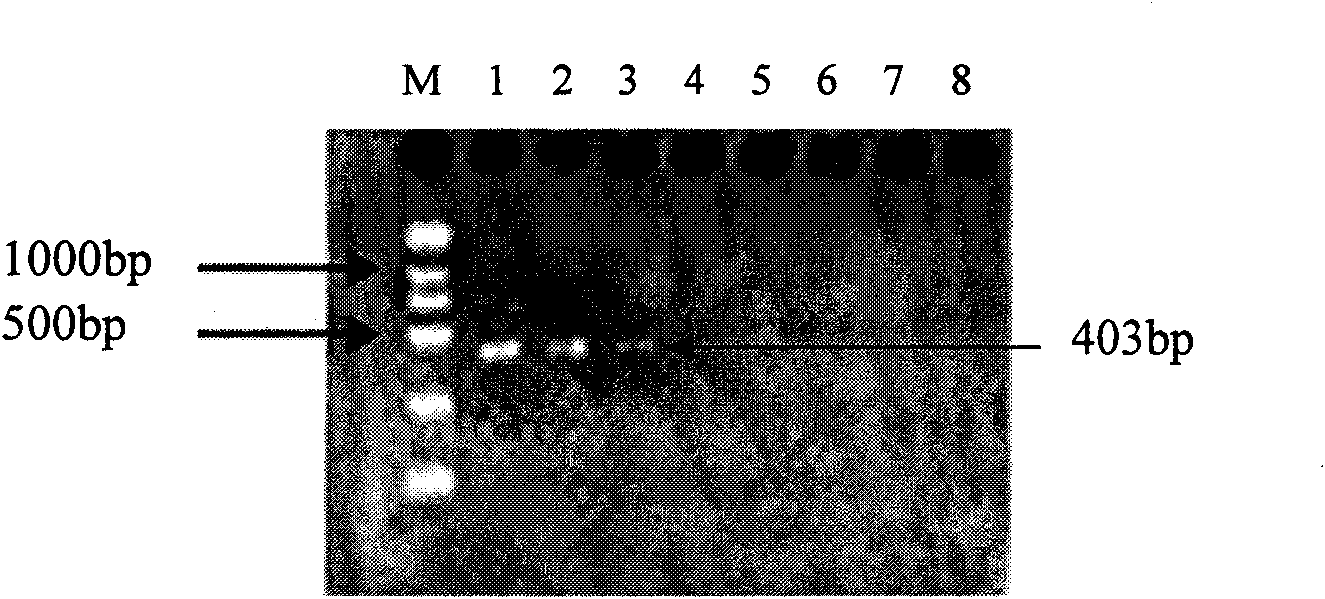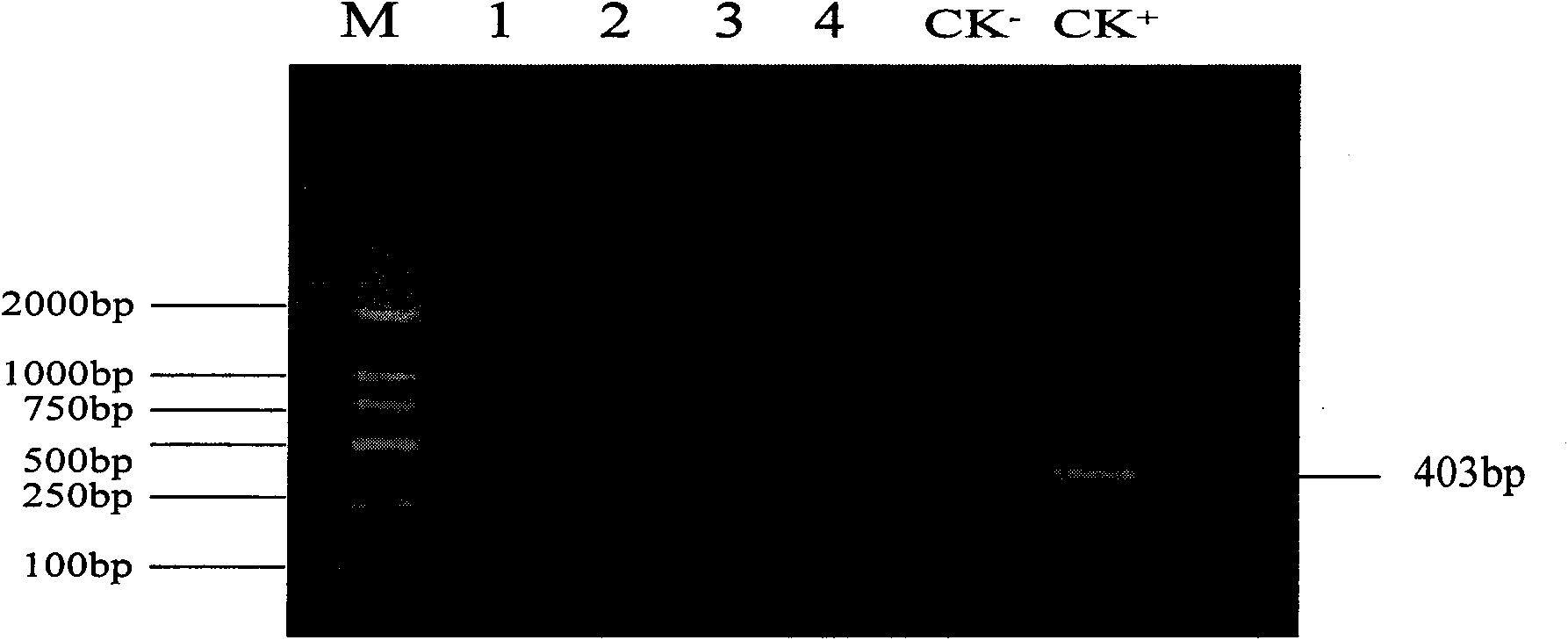Primer and method for detecting specificity of pine wood nematode in Chinese red pine died wood of illness, and application thereof
A technology of pine wood nematode and detection method, which is applied in the field of genetic detection of pine wood nematode, can solve problems such as high technical difficulty, difficult determination of separation results, and increase of uncertain factors, so as to improve detection efficiency, save separation time, Detect quick effects
- Summary
- Abstract
- Description
- Claims
- Application Information
AI Technical Summary
Problems solved by technology
Method used
Image
Examples
Embodiment 1
[0051] Embodiment 1 Primer specificity test of the present invention
[0052] 1. Prepare primers: Synthesize the specific detection primers of pine xylophilus in the diseased and dead wood of Pinus massoniana by Gene Synthesis Company, the nucleotide sequence of its upstream primer is as shown in SEQ ID NO: 1, and the nucleotide sequence of the downstream primer is as shown in SEQ ID NO: 1. ID NO: 2. Primers were stored in a -20 refrigerator.
[0053] 2. PCR amplification
[0054] PCR amplification reaction system: 10×PCR buffer 2.5μl (Mg 2+ free), dNTP (2.5mmol L -1 )2 μl, Mg 2+ (25mmol·L -1 ) 3 μl, each of primers P1 (10 μM) and P2 (10 μM) 1 μl, Taq DNA polymerase 5U·μl -1 0.125 μl, template DNA 2 μl, and sterilized double distilled water to make up to a total volume of 25 μl.
[0055] PCR amplification reaction conditions: pre-denaturation at 94°C for 3min; denaturation at 94°C for 45s, annealing at 53°C for 30s, extension at 72°C for 1min, after 35 cycles, and fina...
Embodiment 2
[0072] Example 2 Preparation of DNA template from diseased and dead wood of Pinus massoniana
[0073] This example optimizes the amount of WLB and proteinase K required for the preparation of DNA templates from dead wood of masson pine.
[0074] The DNA template was prepared by using the diseased and dead wood of Pine masson. If 2 mg of the dead wood of Masson pine was used, it was difficult to amplify the target fragment, so 5 mg of the dead wood of Masson pine was used for the test.
[0075] Prepare WLB lysate, the formula is: containing 2.5mmol L -1 Dithiothreitol, 1.125% Tween-20, 0.025% gelatin, 125mmol L -1 KCl, 25mmolL -1 Tris-HCl (pH 8.0) and 3.75mmol L -1 MgCl 2 .
[0076] Proteinase K is commercially available.
[0077] In this example, three kinds of lysates are used: (1) 32 μL of WLB lysate and 4 μL of proteinase K; (2) 100 μL of WLB and 8 μL of proteinase K; (3) 200 μL of WLB and 10 μL of proteinase K. Prepared operations:
[0078] Put 5 mg of dead wood...
Embodiment 3
[0080] Example 3 Optimization of PCR amplification conditions
[0081] In this embodiment, the annealing temperature and magnesium ion concentration in PCR amplification are optimized.
[0082] 1. Optimization of annealing temperature
[0083] Using 47°C, 47.6°C, 48.2°C, 49.4°C, 50.8°C, 52.2°C, 53.7°C, 55.1°C, 56.6°C, 57.8°C, 58.4°C and 59°C as temperature gradients, the genomic DNA of pine xylophilus was amplified by PCR , PCR amplification results such as Figure 6 As shown, clear bands can be amplified at the 12 tested temperatures, and the PCR yields are the largest at 52.2°C and 53.7°C, so the annealing temperature of the present invention is preferably 53°C.
[0084] 2. Optimization of magnesium ions
[0085] In the 25μL PCR amplification reaction system, take 1.5mmolL -1 , 2.0mmolL -1 , 2.5mmolL -1 , 3.0mmolL -1 , 3.5mmolL -1 and 4.0mmolL -1 A total of 6 gradients of magnesium ion concentration were used to perform PCR amplification on the genomic DNA of pine x...
PUM
 Login to View More
Login to View More Abstract
Description
Claims
Application Information
 Login to View More
Login to View More - R&D
- Intellectual Property
- Life Sciences
- Materials
- Tech Scout
- Unparalleled Data Quality
- Higher Quality Content
- 60% Fewer Hallucinations
Browse by: Latest US Patents, China's latest patents, Technical Efficacy Thesaurus, Application Domain, Technology Topic, Popular Technical Reports.
© 2025 PatSnap. All rights reserved.Legal|Privacy policy|Modern Slavery Act Transparency Statement|Sitemap|About US| Contact US: help@patsnap.com



